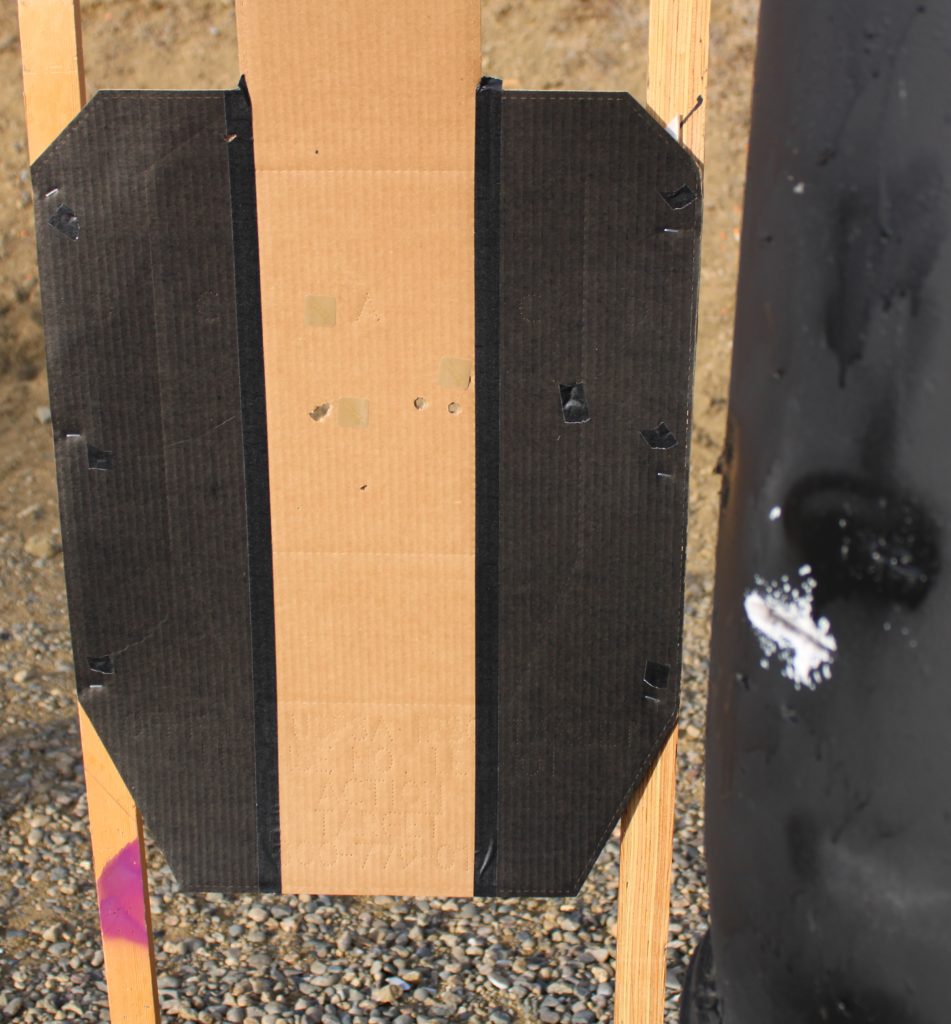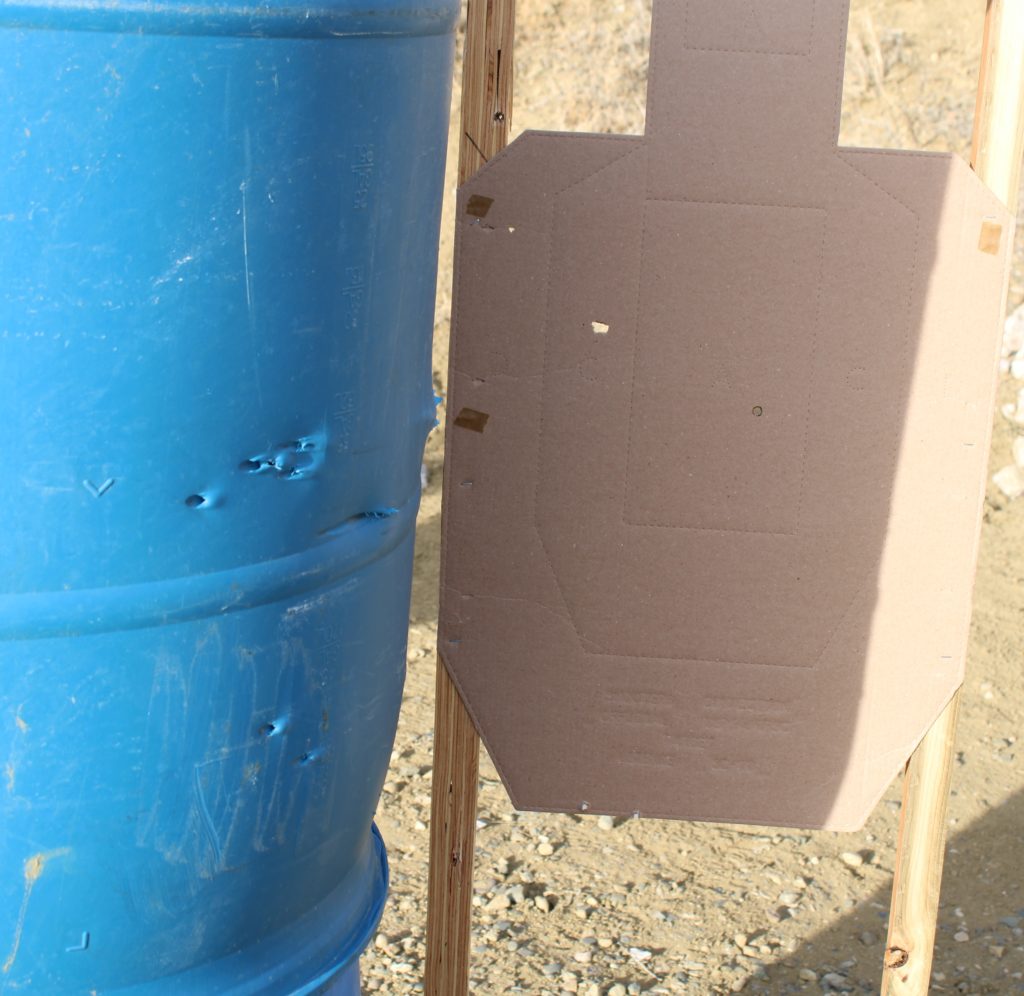Shots that travel partially or wholly through props and hit a cardboard target usually require a bit of detective work by the RO to determine the proper score. Let’s talk about how a RO should score these targets and some tricks to avoid scoring issues.
When it comes to shots that impact walls, barrels, and other barriers used in course construction, the rules are clear about how to score the hits through hard cover (see 2.2.3.4). Any full diameter hit through hard cover will not count for score or penalty on a cardboard target, while a partial diameter hit will count for score or penalty (see 9.1.6). Bullets that strike a wall or barrel, even if it is only a partial diameter hit, will often change trajectory dramatically and may hit a part of the target or a no-shoot that was far from the point of aim.
When an RO scores a target that is in a location where a barrier may be struck by a bullet, it is important to inspect the barrier so that an accurate score can be determined. Experienced ROs can often identify likely places where a barrier will be shot – a tight lean or an awkward position is a common one – and will keep an eye on the barrier while the competitor is shooting. When targets are scored, a struck wall or barrel must also be inspected to determine if the shot was a full or partial diameter hit so that the target in question can be scored correctly. A bullet that passes through a barrier, whether full diameter, partial diameter, or an edge skim, will usually have a different appearance from a clean hit on the same target. While this is a good indicator that the RO should inspect nearby barriers, the barriers should be evaluated as part of the stage scoring process regardless.


One of the difficulties associated with determining the nature of the barrier hit, and the main subject of this article, is the condition of the barrier in question. We often see walls or barrels used in course construction that have multiple unrestored bullet holes, which makes it difficult or impossible to determine which shot, if any, should be attributed to the competitor. In this article, we offer some ideas about how to prepare and maintain walls and barrels to make it easier for the RO to determine the correct call.
Walls are typically constructed of wood frames with some type of mesh or fabric serving as the sheeting of the wall. In the interest of being able to see downrange for safety reasons, snow fence or a geotextile is commonly used; this results in a little bit of make-believe that the walls are both impenetrable and obscure the downrange area. Actual vision barriers on the edges of the walls may help to protect them – more on that later. Back to the wall frame, whether wood, plastic, or metal: this is the part of the wall most likely to be struck by a bullet and therefore it is important to prepare these correctly and to restore them if they are hit. Painting the wall frame is a good step: if the wall is hit by a bullet, it can be touched up with a shot of spray paint the same way that we restore a steel target. That way, we can be sure of new shots that have struck the wall edge. Duct tape can also be used to restore a wall edge and is a good solution for unpainted walls, but make sure that the placement of the tape does not change the profile of the wall edge; often a bullet hitting a wall will remove enough material that the corner is no longer sharp or the profile has otherwise changed.

Another simple idea that both protects wall edges and simplifies scoring is to place a piece of sacrificial lumber on the wall edge. This can be a short piece of 2×2 or lath screwed to the wall in a location likely to get shot; an example is shown in the photo below. If the sacrificial piece is damaged it can be restored with paint or tape and replaced entirely if the damage is too extensive. Use of these pieces also serves to direct the competitor’s aim farther from the wall itself. Last, and getting back to our make-believe wall construction, opaque vision barriers, constructed of cardboard or coroplast or something similar, can be attached at the end of a wall near a target array; this will help to obscure the competitor’s view of the target until he is clear of the wall. This can serve to both slow the competitor down, taking more careful shots, and help to prevent him from engaging the target through the wall mesh.
Barrels are commonly used to hide targets in a course of fire. We’ve all shown up to matches where the barrel stacks have more holes in them than a block of Swiss cheese. This makes it difficult, if not impossible, to determine if a competitor hit a barrel and whether it was full or partial diameter. Often, the RO will rely on sight or sound while the competitor is shooting or decides whether the barrel was hit after inspecting the look of the bullet hole on the target. Neither of these methods of scoring are confidence-inspiring and are more likely to result in an inaccurate score or an undeserved reshoot.
There are numerous ways to prepare barrels so that scoring is easier and more accurate. Painting the barrels is the most common approach; that way, as long as the barrels are inspected and painted after each competitor, it is much easier to determine an accurate score. A word of advice: paint the barrels a color that contrasts with the barrel itself. That is, if you are using blue or white plastic barrels, they can be painted black and the hits are very easy to see – not only is the paint disturbed, but the color of the barrel is plainly visible. Hit the new barrel strikes with a shot of spray paint and you’re ready to go again. It is occasionally necessary to trim some of the barrel plastic after they are struck; this can be done with a pocketknife before restoring with paint. The photos below show the contrast in ease of seeing a barrel hit between a painted and unpainted barrel.


Using duct tape to restore a barrel is another option but may not be ideal. Tape may not stick well to the barrel and will often degrade in the sun and weather. Using a plastic film to wrap the barrels is also an option but may not be ideal. The cost of the wrap may be prohibitive relative to the cost of paint, and the wrap can make it difficult to determine full vs. partial diameter hits. Even just painting the side of the barrel nearest the target after setup will be a big help when it comes to scoring.
Painting walls and barrels can be a time-consuming task when it is initially done and may need to be a work party item during the off-season. Pick an inexpensive house or barn paint in a color that can be touched up with spray paint, see if you can find a club shooter with a paint sprayer, pick a weekend, and you’re halfway there. Pizza and beer bribery may increase participation. Once the initial time investment is put in, maintaining the condition of the barriers is fairly simple. Inspection and restoration of the walls during scoring and reset takes only a few seconds. Not only do the props look nicer, the ROs and competitors both appreciate the accurate scoring calls.
As with all things related to our hobby, the props are only as good as the attention paid to them. A beautifully painted wall or barrel still needs to be inspected while scoring each competitor, and restored afterward, or you will not be able to make a confident scoring call.